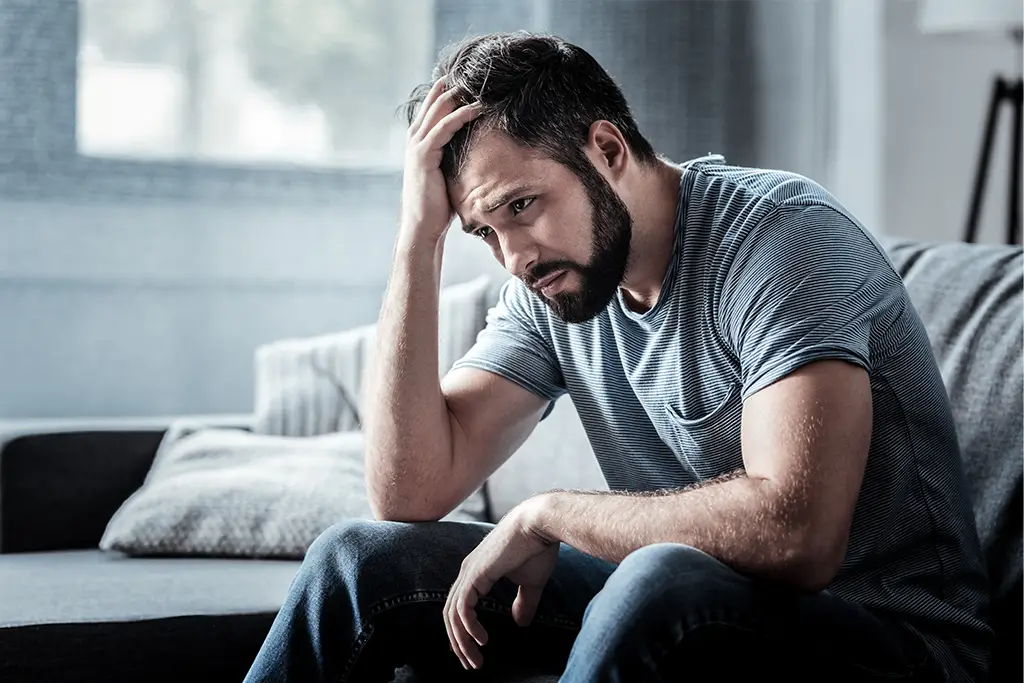What Are the Symptoms of Male Hypogonadism?
Low testosterone can show up in a lot of different ways, especially depending on your age. Symptoms that strongly point to low testosterone in people who were born male include
- Loss of libido
- Trouble getting an erection
- Hair loss in the armpits and groin area
- Testicles get smaller
- Hot flushes
- Low or no sperm count, also known as azoospermia, can cause infertility
Other symptoms of male hypogonadism indicating an adult has low testosterone are:
- Depression
- Having trouble focusing and remembering things
- Obesity
- Gynaecomastia (Enlarged breasts)
- Loss of muscle bulk and strength
What Are the Causes of Male Hypogonadism?
The primary causes of male hypogonadism may differ depending on whether you are experiencing primary hypogonadism or secondary hypergonadism.
Primary Hypogonadism: In this case, the problem is in the testicles. It’s also known as primary testicular failure. The causes may include:
- Undescended testicles (cryptorchidism) during development
- Injury or infection of the testicles (orchitis)
- Genetic conditions (Klinefelter syndrome)
Secondary Hypogonadism: Here, the testicles function normally, but there’s a problem in the parts of the brain responsible for signalling testosterone production. The causes may include:
- Pituitary gland problems (tumours, injuries)
- Certain medications (chemotherapy, steroids)
- Obesity (can affect hormone signalling)
- Ageing (natural decline in testosterone production)
Male Hypogonadism Treatment Options
The best treatment for male hypogonadism depends on the underlying cause and your individual circumstances. Here are the most common approaches:
Lifestyle Changes:
These include:
- Weight loss can significantly increase testosterone levels.
- Regular exercise, especially strength training, helps raise testosterone.
- A balanced diet with fruits, veggies, and whole grains fuels testosterone production.
- Limit processed foods, unhealthy fats, and sugar.
- Practice relaxation techniques to manage stress.
- Aim for 7-8 hours of sleep for optimal hormonal health, including testosterone regulation.
Testosterone Replacement Therapy:
Testosterone replacement therapy is the preferred male hypogonadism treatment. The goal of this treatment is to ease signs like loss of libido, tiredness, hair loss on the face and body, and less muscle mass and bone structure. Its effectiveness in men with male hypogonadism due to ageing is unclear.
During testosterone replacement therapy, it is best to have regular check-ups with a doctor to see how well the treatment is working and to handle any side effects that might happen. There are different kinds of testosterone replacement, such as:
- Gels and Solutions: These can be put on the skin of the upper arm, shoulder, thigh, or chest. Brands like AndroGel, Testim, Vogelxo, and Fortesta are some examples.
- Patches: Androderm patches are put on the legs or chest every night.
- Gum and Cheek (Buccal Cavity): A putty-like material is put on top of the upper teeth and along the gumline. This releases testosterone into the bloodstream.
- Nasal Gel: This gel is pumped into the nose, and it needs to be used several times a day.
- Implantable Pellets: Every couple of months, testosterone-filled pellets called Testopel are medically put under the skin.
Treating the Underlying Cause
In some cases, addressing the root cause of low testosterone is a more efficient therapeutic course. For example, if Klinefelter syndrome causes hypogonadism in a person, managing that condition might be the primary focus. In some cases, drugs can, as well, cause low testosterone in men. If this is the case, your doctor might recommend alternative medications.
Conclusion
Low testosterone in men, which is known as male hypogonadism, can have a major effect on anyone’s physical and mental health. Recognising the signs, like reduced libido, tiredness, and muscle loss, is important for getting a correct diagnosis and treatment as soon as possible. Testosterone Replacement Therapy (TRT) is a popular way to adjust hormone levels and ease symptoms. There are different ways to administer TRT to meet the needs and preferences of each person. Ultimately, getting medical advice and personalised care is the only way to successfully treat male hypogonadism and enhance the general quality of life.

